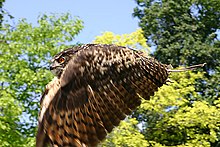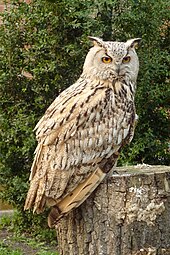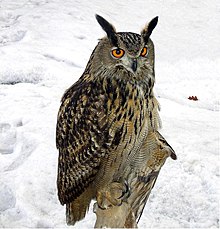Eagle owl
| Eagle owl | ||||||||||
|---|---|---|---|---|---|---|---|---|---|---|
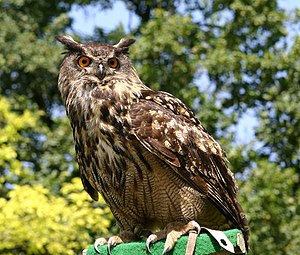
Eagle owl ( Bubo bubo ) |
||||||||||
| Systematics | ||||||||||
|
||||||||||
| Scientific name | ||||||||||
| Bubo bubo | ||||||||||
| ( Linnaeus , 1758) |
The owl ( Bubo bubo ) is a bird art from the genus of owls ( Bubo ) used to order the owls part (strigiformes). Eagle owls have a massive body and a noticeably thick head with feather ears. The eyes are orange-yellow. The plumage shows dark longitudinal and transverse drawings. The chest and stomach are lighter than the back.
The eagle owl is a resident bird that prefers to hunt in richly structured landscapes. In Central Europe, the species breeds mainly in the Alps and the low mountain ranges, but eagle owls have also re-colonized the plains here in recent decades. The breeding grounds are mainly found in rock faces and steep slopes and in old bird-of-prey nests, less often on buildings or on the ground.
etymology
The German name "Uhu", like many of its dialect equivalents, such as "Schuhu", goes back to the impression of his courtship call. The generic name " Bubo " can also be traced back to this characteristic reputation. The name “eagle owl” has been attested for this species of owl since the 16th century . The East Central German eagle owl prevailed over the early New High German Huhu . Other names for the eagle owl used to be: Auf, Juchteule, Huw, Huher, Nachthuri, Eagle Owl and Grand Duke. The name “Grand Duke” was probably motivated by the observation of hatred for him by other birds. In French it is called "grand-duc" for similar reasons. In the past, the eagle owl was often referred to as the king or ruler of the night.
description
The eagle owl is the largest recent species of owl on earth. Females are significantly larger than males (reverse sex dimorphism ). According to Bergmann's rule , the species shows a significant increase in size and weight from southwest to northeast . Males from Norway reach an average body length of 61 cm and weigh between 1800 and 2800 g, on average 2450 g. Norwegian females have an average body length of 67 cm and weigh 2300 to 4200 g, on average 2990 g. Birds from Thuringia weigh an average of 1890 g (males) and 2550 g (females). The heaviest Central European eagle owls weighed 3200 g. The difference in size between males and females is also reflected in the wingspan. The average span of the males is 157 cm, that of the females 168 cm.
The head is large and has remarkably long feather ears . These are usually at an angle to the side or back. The eagle owl also has the face veil typical of owls , which is less pronounced than, for example, in the long-eared owl or barn owl .
The body plumage in Central Europe is a light brown with dark longitudinal and transverse stripes. The back is darker than the belly, and the undersides of the wings are also fletched lighter. The individual subspecies of the eagle owl differ in their body size and in the basic color of their plumage.
Existence and distribution
Eagle owls belong to the owl species with a very large distribution area. They are native to North Africa as well as Europe and Asia . In Europe, the species is absent in the northern half of France, Ireland, Iceland and most of the islands of the Mediterranean. In Great Britain there are only 2 to 10 breeding pairs, which can be traced back to escaped eagle owls. This reintroduction of the eagle owl in the British Isles, after it has not lived there for hundreds or thousands of years, is controversial among ornithologists, as it is feared that it will cause serious changes in the native bird world. In Europe (excluding Russia) around 12,000 breeding pairs were breeding in 2008, 3300 of them in Central Europe. In Germany the number is estimated at 2000 breeding pairs (2016), in Austria at at least 400 (2008), in Switzerland at around 100 breeding pairs (2008). The population of the eagle owl has increased sharply in Germany since the mid-1980s due to protective measures and reintroduction campaigns. However, in Europe, especially in Western Europe, large areas of the lowlands are still not repopulated. Intensively used agricultural landscapes are avoided entirely. In contrast, cities and metropolitan areas are now being settled, at least in individual cases. Eagle owls now breed with several breeding pairs in Hamburg and Helsinki.
On the IUCN Red List, the species is classified with LC ( Least Concern , English for not endangered ). It belongs to Appendix I of the EU Bird Protection Directive (RL 79/409 / EEC) and Appendix A of the EU Species Protection Ordinance . In Germany, the species is no longer on the red list due to many bird protection measures. However, it is one of the specially and strictly protected species according to Section 7 (2) No. 13 and 14 of the Federal Nature Conservation Act .
habitat
Settlement areas and location requirements
Mainly due to human persecution, the eagle owl in Central Europe was largely restricted to the low mountain ranges and the Alps. Meanwhile, the plains are increasingly being repopulated. The typical hunting ground or grazing area has an average size of 40 square kilometers. In its area of distribution, the eagle owl shows how much it can adapt to the different conditions of its habitat. Eagle owls live in almost treeless desert mountains and steppes, in the light boreal coniferous forests and in subtropical latitudes. They can also be found on the coast of the sea.
The hunting ground, which is ideal for the eagle owl, is diversely structured and criss-crossed by hedges, bodies of water and field trees as well as open fields. While eagle owls defend the narrower area around the nest, this does not apply to their hunting ground. This partially overlaps with that of neighboring individuals. In habitats that offer optimal conditions, the population of eagle owls can be very dense. In the south of France , for example, 28 breeding pairs were counted on an area of 140 square kilometers.

Breeding site
The eagle owl has become a rock breeder in Central Europe. It likes to nest in rock walls, niches and ledges. Well-suited breeding sites are often occupied by eagle owls for generations. Numerous former and current breeding sites therefore have names such as Uhufelsen, Uhuwand, Uhuturm, Eulenwand, Uhulegge and Schuwutt.
The eagle owl also uses man-made quarries as a breeding site - in 2005, 64 percent of the breeding sites in Germany were in such so-called “secondary breeding biotopes”. It is even often done in quarries that are still in operation. However, the prerequisite is that the immediate breeding area is not disturbed. In operated quarries there are individual breeding losses due to the mining activity. However, studies have shown that reproduction in operating and disused quarries is practically identical.
In regions where no rocks are available - such as Schleswig-Holstein - the eagle owl often breeds on the ground or in abandoned bird of prey nests, mostly in buzzards or goshawks . Up until the 18th century there were also frequent building hives at ruins and churches. Since 1975 there has been an increasing number of building broods. In addition to ruins and churches , industrial buildings are also used.
behavior
Rest and comfort behavior
Eagle owls spend the day protected in tree tops, rock niches or bushes. Mostly eagle owls sit upright on their resting branches. Occasionally, however, they also lie down with their sternum on a strong branch. Like almost all species of owls, eagle owls like to sunbathe, sometimes lying flat on the ground. Even in the rain they show a comfortable posture in which they fan out their wings and raise their body plumage. When sand bathing, they shovel sand with their wings on their necks and backs.
Camouflage and threaten
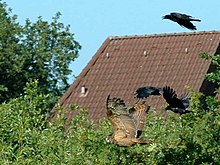
In their resting places, eagle owls camouflage themselves with their erect feather ears and eyes narrowed to narrow slits. In this way they hide their eye-catching facial contours with their large eyes, even from day birds, which react aggressively to an eagle owl discovered during the day, loudly draw attention to the discovered eagle owl and sometimes even fly fake attacks on the nocturnal predator (so-called “ hating ” or “bullying” “, Compare also the article owls ). A cornered eagle owl ruffles its plumage, snaps its beak and hisses. It then also fans out its tail, forms a large impeller with its wings and visually increases its body size.
Calls
The eagle owl has a large repertoire of calls. During courtship, the male lets out a muffled “buho” that can be heard up to a kilometer away. The female responds to this call with a lighter “u-hu”. Often both sexes call in a duet. During mating, an excited "hohohoho" can be heard from the male and a shrill "wiwiwiwi" from the female.
A whole series of other sounds also belong to courtship behavior:
- With syllables "buhju" or "ujo" that merge softly in glissando, the male lures when "pointing the nest" and handing over the prey. These "haunting" sounds are both lined up in quick succession and individually combined with other sounds (e.g. feeding sounds). A cautiously quiet series of chuckling-cackling syllables is used by the male to demonstrate a prospective nesting trough in quick succession (soft "gu.dugg-gu.dugg-gu.dugg", with an emphasis on the second syllable). This sound corresponds in character to the feeding sound ("dugge-dugge" or "glugg-glugg") with which the female encourages the nestlings to take prey. (Mebs, Scherzinger, p. 157)
Nestlings call initially quiet "chnää" which Ästlinge let other hand, a hissing and rough "chau" or "chtscht" hear. Branchlings show great endurance. Their calls, which can be heard from afar, can last for hours.
Reviergesang (male)
Hunting way
The eagle owl is a nocturnal hunter who goes hunting at dusk, takes a break from hunting around midnight and then continues to hunt until dawn. He only shows hunting activities during the day during periods of hunger. When hunting ground-dwelling mammals, it controls its territory by gliding or rowing flight just above the ground. If he hunts birds, on the other hand, he flies at the top of the trees. When hunting birds, it can reach very high flight speeds; it is able to overtake ravens, crows or pigeons in flight and is agile enough to pursue a bird even in dense trees. However, he prefers to hit his prey when it is either resting on the branches at night or when it is startled by him.
The eagle owl is also a skilled hunter on the ground, able to hunt with sweeping strides. He is able to catch up with a fleeing mouse on the ground. However, it also searches the ground for snails , earthworms and other invertebrates . Shore areas and tidal zones by the sea are searched for crabs and fish.
food
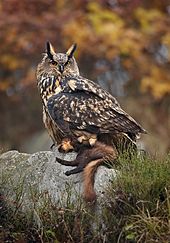
Eagle owls feed primarily on small to medium-sized mammals and birds. Hedgehogs , rats , mice , rabbits , brown hares , corvids , pigeons and ducks are among its prey in Central Europe . More than 50 different species of mammals and almost 180 species of birds have been identified in its ridges . The prey scheme has been extensively analyzed in many regions of Europe. These analyzes show that the eagle owl is capable of preying a large number of animal species, but usually hunts the species that are particularly common in its hunting ground. For example, studies in Burgenland show that with the general decline in the number of partridge , the proportion of partridges among the animals captured by the eagle owls also decreased.

Eagle owls can carry away prey in flight that weigh up to two thirds of their body weight. Their prey therefore occasionally also includes eider ducks , which can weigh up to 2.2 kg , young rookies , marmots , young foxes or weak fawns . But they also beat gray herons , hawks and other owls. The tawny owl and the long-eared owl are among the species of owl that they often capture . At least in Central Europe, insects, amphibians and fish are rarely hunted. Occasionally, eagle owls also go to carrion .
Vaults
The prey components that are indigestible to the eagle owl, such as hair, feathers, bones, claws, beaks and teeth, are choked out in bulges , also called spits. Sometimes skulls of smaller prey animals are also found in ridges. Captured hedgehogs are turned around and then, so to speak, peeled off, so that at the end the scraped-off hedgehog rind with the hedgehog spines remains on it, but hedgehog spines can still be found in crusts. In extreme cases, a vault can consist almost entirely of hedgehog spines. Smaller prey are completely devoured, while larger prey is plucked (at least the large plumage) or cut. In the case of larger prey, the head is cut off first. In prey depots there are usually larger prey animals such as B. Headless brown rats . Parts of larger bones that have been bitten or broken through are often found in the ridges. Because of their size, uhu bulbs are actually distinctive. They have a length of 4.3 to 12.9 cm, on average 7.2 cm and a diameter of 1.9 to 4.4 cm, on average 3.4 cm.
Reproduction
Courtship
The autumn show of the eagle owls begins in September. Now old pairs can be found again in the immediate vicinity of their breeding site, and new pairs find each other. The autumn balz goes from September to November. If there is no hard onset of winter, the autumn courtship can seamlessly transition into the actual courtship. The courtship ends after the eagle owls start breeding. Males who do not yet have a partner call very persistently and intensely. Intensive calling has also been observed in female eagle owls whose partner has died and who were left alone in the original territory. Individual houses in a district can call intensively until June.
It is also part of courtship behavior that the male tries to lure the female to the selected nesting site with lure and feeding sounds. If the female accepts the nesting site, the male begins to provide the female with prey, often weeks before the actual start of breeding. However, every 5th pair of uhu does not brood - this may be due to insufficient prey, for example.
Brood
From December onwards, breeding troughs are scratched at possible breeding sites by uhu pairs. From this time on, the female no longer hunts and is provided with food by the male. The first eagle owls begin to breed in Central Europe at the end of February. Most eagle owls start to breed in March. The rest of the breeding pairs follow in April. If a clutch is lost at the beginning of the breeding season, a new clutch can occur.
A clutch usually consists of two to three, occasionally four, exceptionally one or five eggs, which are laid three to four days apart and are incubated by the female alone. Since the Uhuweibchen during breeding breaks always flies only at a few sites for defecation, this fall through the so-called brood ships on. Studies by scientists at the state research institute CSIC in southern Spain indicate that eagle owls appear to use their droppings and the feathers of prey to mark the territory around their nest. The birds of prey mark the area around their nest especially during the time when the females are breeding or the young need special protection. The chicks hatch after 34 days. It can take up to 24 hours for a Uhuk chick to hatch. The newly hatched eagle owls wear a whitish down dress and weigh an average of 60 grams. At the age of six days, the nestlings are able to squat on their heels for the first time; at 16 days they can already stand. The point in time at which the nestlings leave the nesting trough and become branchlings depends on the breeding site. The Junguhus stay in protected rock niches for up to 10 weeks; if, on the other hand, the nesting trough is on the ground, the young migrate at 3.5 weeks. However, eagle owl cubs cannot walk, jump and climb safely until they are four to five weeks old. The Junguhus start flying at the age of 8 weeks. The parents care for their offspring up to about 5 months of age. However, on average only three out of 10 Junguhus survive the first year of life.
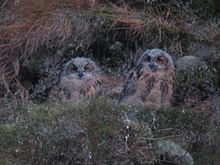
Predators and life expectancy
Other predators are only dangerous to a fully grown, healthy and flightable eagle owl in exceptional cases. Only golden eagles strike juvenile and adult eagle owls more often at the breeding site. But eagle , steppe eagle and Bonelli's eagle can capture owls. Junguhus, on the other hand, are at risk. Foxes and martens, for example, eat Junguhus if they can reach them at their breeding sites. One of the protective measures that are taken to preserve the population used to be the protection of breeding grounds in quarries against access by foxes. In the occasional floor brood, the clutch and the chicks are also endangered by wild boars .
Even if the mortality rate of the young owls is 70% during their first year of life, the eagle owls that survive this critical phase can reach a considerable age. Due to ringing, the maximum age of 27 years for eagle owls living in the wild has been proven so far. Aviary birds can age considerably. The Methuselah among the eagle owls kept in aviaries reached an age of 68 years, but an age of 28 to 34 years is more typical for aviary birds.
Subspecies
A number of subspecies have developed within the great range of the eagle owl. Different authors differentiated up to twenty subspecies, some of which differ significantly in the basic color of the plumage and in body size. According to recent studies of both calls and DNA, 14 subspecies are currently distinguished. Since no comparative studies have yet been carried out in parts of Asia, the exact number of subspecies is still open. It only recently turned out that the subspecies Bubo bubo ascalaphus , which lives in North Africa and the Middle East, is a separate species ( Bubo ascalaphus , Wüstenuhu or Pharaonenuhu). The smallest subspecies Bubo bubo hispanus lives on the Iberian Peninsula. The list of 14 subspecies presented here is essentially based on König, Weick, Becking 1999. In some cases, the exact delimitation of the subspecies is unclear because there are mixing areas.
- B. b. bubo : Europe from the Pyrenees to Northwest Russia (Pechora River) and Ukraine.
- B. b. hispanus : Iberian Peninsula and forested areas of the Atlas Mountains in North Africa.
- B. b. ruthenus : East of the line Pechora river-Moscow-Volga middle reaches to western Siberia.
- B. b. interpositus : Moldova, steppe regions of Ukraine with Crimea, the Caucasus, Asia Minor, northwest Iran, northern Iraq, Syria and Palestine. It may be a species of its own.
- B. b. sibiricus : West Siberia and Bashkiria to the Middle Ob and West Altai Mountains. North to the edge of the taiga. It is the largest subspecies of the eagle owl.
- B. b. yenisseensis : Central Siberia to the northern edge of the taiga.
- B. b. jakutensis : Northeast Siberia to the northern edge of the taiga.
- B. b. ussuriensis : Southeast Siberia, North China, Sakhalin and South Kuril Islands.
- B. b. turcomonus : East of the lower reaches of the Volga to Western Mongolia. North to the Ural Mountains and south to the Caspian Sea and including the Turim lowlands (Central Asia).
- B. b. omissus : Turkmenia, northeast Iran to northwest China
- B. b. nikolskii : southern Iraq, western Iran to Pakistan
- B. b. hemachalana : Western China with Tibet and Afghanistan.
- B. b. kiautschensis : Korea and North China to the provinces of Yunan and Sichuan.
- B. b. swinhoei : Southeast China.
Human and eagle owl
Use in hunting
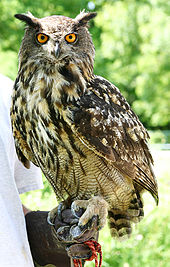
The eagle owl, like most other owl species, has an optical appearance that can be recognized by other birds. Birds react to owls discovered in hiding during the day with a clear aggression behavior and gather near an owl's hiding place, hate the predator by calling out loudly and sometimes even fly attacks.
Man has made use of this again and again. One of the most common types of owls used for such so-called hut hunts was the eagle owl. For hut hunting, the eagle owl was usually pegged on a tree stump in front of the hunter's hiding place. For example, crows and birds of prey were hunted with the eagle owl as a decoy. As a result, hunters paid attractive prices for eagle owls caught alive or hoarded, which in some regions led to a dramatic decline in the populations.
Change in the appreciation of the eagle owl
Until the 20th century, the eagle owl was considered a hunting pest that had to be combated. One saw in him a hunting competitor who had hunting animals such as pheasant , brown hare and deer for prey. By the end of the 1930s, the eagle owl was almost completely exterminated in large areas of its previously populated area in Central and Western Europe due to the intensive hunting and the removal of junguhus for hut hunting.
Most hunters now have a much more realistic picture of the prey pattern of an eagle owl and its role in an intact biotope. In addition to statutory protective measures, this has contributed significantly to the resettlement of eagle owls in regions that have since been uho-free.
Causes of danger
In 2009, the Society for the Conservation of Owls compiled non-representative statistics on the causes of death of 1667 adult ringed eagle owls that were found in six federal states between 1965 and 2008. 26 percent of the eagle owls suffered an electric shock (see bird strike ) on a medium-voltage line and 6 percent on a railway overhead line.
Section 41 of the Federal Nature Conservation Act has obliged network operators to convert the existing masts and components by 2012 so that birds are protected from electric shock. However, the conversion obligation does not apply to the overhead lines of the railway. In Switzerland, only bird-safe constructions are permitted for new overhead lines. A renovation of existing electricity pylons is only necessary if they pose "an imminent danger to people and the environment". In other countries with an owl population, there is no legal obligation to convert medium-voltage pylons ; even newly erected medium voltage pylons do not need to be bird-proof. The number two cause of loss was traffic with almost 30 percent. Almost 24 percent of this was on roads and 5 percent on railway lines. The on road existing railway line and edges Saumhabitate and partly an increased volume of waste lead to larger rodents deposits. Eagle owls can collide with vehicles or be caught by their vortices when they hunt, fly over a road or pick up freshly dead animals on a road or railroad.
Another 10 percent of the eagle owls were found as so-called wire victims, mostly caught on barbed wire. Occasional dead eagle owls have been found on wind turbines .
In Switzerland too, electric shocks are the most common non-natural cause of death for eagle owls, accounting for around a third.
Resettlements by humans
In some regions, the eagle owl was made home again by releasing bred individuals, for example in the Harz and the Eifel .
Different methods are used for reintroduction. One of the most successful methods used to strengthen remaining populations is the so-called adoption method, in which eggs or young birds are pushed under unsuccessful breeding eagle owls. The young eagle owls then grow up under natural conditions and do not show any faults caused by rearing in human care.
To colonize new areas, it has proven useful if eagle owls grow up with their parent birds in enclosures in the region that they are to colonize later. They are then released directly from the breeding enclosure. This method has been used particularly successfully in the Bavarian Forest , where evaluations of various reintroduction methods have shown that this method is the most likely to ensure that the Junguhus remain in the area.
Protective measures
The most important measure to preserve the underground population is the preservation of diverse structured landscapes. Another component is the prevention of disturbances during the brood which can lead to the brooding abandonment.
Natural rocks and quarries with breeding occurrences can be protected as a nature reserve (NSG) or natural monument (ND) in order to preserve breeding opportunities. This is common practice in some federal states.
Possible breeding disturbances by climbing athletes are countered by concepts for nature-friendly climbing (climbing concepts). For this purpose z. For example, the German Alpine Association founded the “Climbing and Nature Conservation Commission” in 1991, which, together with the authorities and nature conservation associations, develops usage regulations, including rock closures.
One of the protective measures that specifically served the eagle owl used to be the eyrie guard, which prevented breeding eagle owls from being disturbed at their breeding site. With a breeding population of approx. 1500 breeding pairs (2008) this is no longer necessary and has therefore been discontinued.
Cultural history
The eagle owl is mentioned in the folk song Die Vogelhochzeit , but this is the exception in terms of cultural history . Legends and fairy tales usually tell unspecifically about owls and rarely differentiate between the individual large species of owls. Even Shakespeare mentioned owls, but renounces sure to name the species. For this reason, the cultural-historical features are mentioned in the article about owls .
In his translation of the Old Testament, Martin Luther mentions the Huhu ( Leviticus 11, 17) or the eagle owl ( Deuteronomy 14, 16) as one of the unclean bird species that should not be eaten. In these purity laws, some other translations speak of other types of owls instead of the eagle owl; the order of the animals mentioned also varies from translation to translation.
The name of the synthetic resin adhesive eagle owl , which was launched in 1932 and named after the bird, does not refer to any special properties of the eagle owl. The naming of branded articles according to bird species was widespread in the German stationery industry at the time, after the Pelikan brand, named after an entrepreneur's heraldic animal, was very successful in 1896 . The eagle owl was selected because it was native to the Bühl production site near the Black Forest.
Le Grand-duc ( Dead Eagle Owl ) is a work by the French painter Édouard Manet . The picture shows a dead eagle owl hanging upside down on a wooden wall as a hunting trophy.
Keeping eagle owls in the zoo
The European eagle owl is kept in over 480 zoo facilities in Europe. Of these, over 200 zoo facilities are in Germany.
Bird of the year 2005
On October 1st, 2004 the eagle owl was named Bird of the Year 2005 in Germany and Austria by the Naturschutzbund Deutschland and BirdLife Austria .
literature
- Adrian Aebischer: Owls and owls. Haupt, Bern 2008, ISBN 978-3-258-07276-0 .
- Lutz Dalbeck: The eagle owl Bubo bubo (L.) in Germany. Autecological analyzes on a resettled population - summary of a species protection project Shaker, Aachen 2003, ISBN 3-8322-1444-5 .
- Jens Hartmann: The eagle owl in Hamburg. Eulenwelt 2009, pp. 23-25.
- Jürgen Nicolai : Birds of prey and owls. Compass nature guide. Gräfe and Unzer, Munich 1987, ISBN 3-7742-3805-7 .
- Urs N. Glutz von Blotzheim (Hrsg.): Handbook of the birds of Central Europe . Vol. 9. Columbiformes - Piciformes. 2nd Edition. Aula, Wiesbaden 1994, ISBN 3-89104-562-X .
- Heinrich Haller: On the population ecology of the eagle owl Bubo bubo in the high mountains: population, population development and habitat in the Rhaetian Alps. In: Ornith. Obs. 75, 1978, pp. 237-265.
- Jochen Hölzinger , Ulrich Mahler: The birds of Baden-Württemberg. Vol. 3. Non-songbirds. Ulmer, Stuttgart 2001, ISBN 3-8001-3908-1 .
- Hans-Günther Bauer, Peter Berthold : The breeding birds of Central Europe. Existence and endangerment. Aula, Wiesbaden 1997, ISBN 3-89104-613-8 .
- Claus König , Friedhelm Weick , Becking: Owls - A Guide to the Owls of the World. Pica Press, Sussex 1999, ISBN 1-873403-74-7 .
- Christoph Leditznig: On the ecology of an eagle owl population in the south-west of Lower Austria. Diss. Univ. Bodenkultur, Vienna, pp. 203ff.
- Martin Lindner: Reproduction of the eagle owl (Bubo bubo) in disused and operated quarries in the Sauerland. In: Species Protection Report. 17, 2005, pp. 15-19.
- Martin Lindner: The eagle owl Bubo bubo in Great Britain. In: Owl Round View. 58, 2009, pp. 46-48.
- Theodor Mebs : Owls and Owls. All European owls and owls. Franckh-Kosmos, Stuttgart 1987, ISBN 3-440-05708-9 .
- Theodor Mebs, Wolfgang Scherzinger : The owls of Europe. 2nd Edition. Franckh-Kosmos, Stuttgart 2008, ISBN 978-3-440-11642-5 .
- Rudolf Piechocki , Robert March : The eagle owl. In: New Brehm Library. 108, A. Ziemsen, Wittenberg 1985, ISBN 3-89432-421-X .
- Raimo Seppälä: Helsingin kaupunkihuuhkajat 2008 - pesimistä keskustassa jo pari vuotta. In: Tringa. 36, 2009, pp. 14-20.
Web links
- The eagle owl at the German Working Group for the Protection of Owls (AG Eulen)
- Eagle owl at the Society for the Conservation of Owls (EGE)
- Profile of Nabu Germany on the eagle owl, the bird of the year 2005
- Begging calls from Junguhus
- State Association for Bird Protection in Bavaria (2012): Development of new protection concepts for the eagle owl (195 pages)
- Transmitted eagle owl high-altitude monitoring in NRW 2015
- Bubo bubo in the endangered Red List species the IUCN 2008. Posted by: BirdLife International, 2004. Retrieved on January 3 of 2009.
- Videos, photos and sound recordings for Bubo bubo in the Internet Bird Collection
- SWR's eagle owl webcam
- Eagle owl webcam in Latvia
- Feathers of the eagle owl
Individual evidence
- ^ The Notorious Eagle Owl. YouTube video, accessed February 26, 2013 .
- ↑ BBC Natural World: The return of the eagle owl (Maastricht). BBC Video (not available from Germany), accessed on February 26, 2013 (English).
- ↑ Uhub status. In: lfu.bayern.de. Retrieved December 5, 2016.
- ↑ Bubo bubo (Eurasian Eagle-owl). IUCN, accessed April 23, 2014 .
- ^ Red list of breeding birds in Germany. NABU, accessed May 23, 2014 .
- ↑ Theodor Mebs, Wolfgang Scherzinger: The Owls of Europe. 2nd Edition. Franckh-Kosmos, Stuttgart 2008, pp. 45-46.
- ^ WG owls: Eagle owl captured by the Bonelli's eagle in Spain , archive: From the everyday life of owl researchers, December 11, 2015
- ↑ Edmund Brandt (Ed.): The field of tension wind energy plants - nature conservation in licensing and court proceedings , BWV 2015, p. 79
- ^ Wilhelm Breuer, Stefan Brücher, Lutz Dahlbeck: Street death of birds - On the question of relevance using the example of the eagle owl. In: Nature conservation and landscape planning. 41 (2) 2009, pp. 41-46 ( online ).
- ↑ Hansjakob Baumgartner: Line masts: So that the owl does not hit the blow. Federal Office for the Environment FOEN, accessed on September 26, 2019 .
- ↑ Brandenburg Bird Observatory: Effects of wind turbines on birds and bats (click on the link 'Birds in Germany').
- ↑ Gian Andrea Marti: Electric shocks endanger Swiss eagle owls. In: nzz.ch. Neue Zürcher Zeitung , April 5, 2018, accessed on February 5, 2019 .
- ↑ Wilhelm Breuer, Stefan Brücher: Dangerous medium-voltage masts and climbing: Current aspects of the Uhuschutzes Bubo bubo in the Eifel (PDF; 272 kB). In: Charadrius , Nordrhein-Westfälische Ornithologengesellschaft, 46th vol., No. 1–2, 2010, pp. 49–55.
- ↑ Mission statement for climbing and nature conservation , German Alpine Association (2014) (PDF; 7.2 MB), accessed on June 16, 2017.
- ↑ German title according to Ina Conzen's exhibition catalog: Edouard Manet and the Impressionists pp. 152 and 240. Other titles used in German-language literature, such as The Great Horned Uhu or Eagle Owl , may be due to translation errors from English-language literature.
- ↑ Zootierliste.de - Attitudes Retrieved on December 5, 2016






